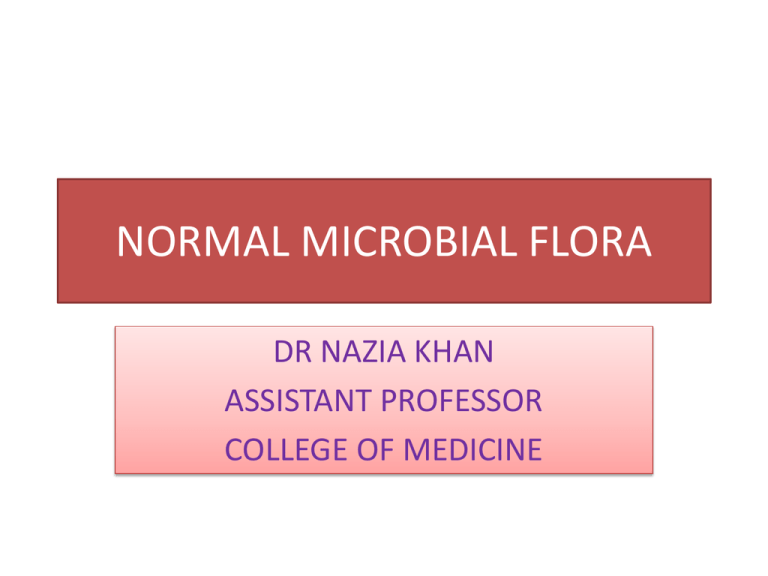Normal Microflora
advertisement

NORMAL MICROBIAL FLORA DR NAZIA KHAN ASSISTANT PROFESSOR COLLEGE OF MEDICINE • Human beings carry a lot of microorganisms both on and in their body. • A knowledge of normal microbial flora is important to an understanding of the interaction of human beings and their pathogen laden environment. BENEFICIAL FUNCTIONS OF NORMAL FLORA 1. Prevent colonization by pathogens 2. Produce antimicrobial substances 3. In newborn it is a powerful stimulus for the development of the immune system 4. Microflora of intestine synthesize vitamin k and several B vitamins 5. Normal flora may produce endotoxins Harmful effects of normal flora 1. When organisms are displaced from their normal site in the body to an abnormal site 2. When potential pathogens gain a competitive advantage due to diminished populations of harmless competitors example: by use of antibiotic therapy 3. When some harmless substances like ingested food are converted into carcinogenic derivatives by bacteria in the colon 4. Immunocompromised individuals 5. Drug resistance 6. Confusion in diagnosis NORMAL FLORA OF THE SKIN • The human skin is constantly bombarded by organisms present in the environment . • It is also contaminated by one’s own secretions and excretions depending on individual’s personal hygiene . • Examples: Staphylococcus Diphtheroids E.coli candida NORMAL FLORA OF THE CONJUCTIVA • It is relatively free from organisms due to the flushing action of tears. • Examples: Diphtheroids Staphylococcus NORMAL FLORA OF THE NOSE, NASOPHARYNX AND ACESSORY SINUSES • In the nose: Corynebateria Staphylococcus • The nasopharynx of infant is sterile at birth • But acquires the common commensal flora and pathogenic flora carried form the mother and hospital staff • Examples: Peudomonas E.coli NORMAL FLORA OF THE MOUTH AND UPPER RESPIRATORY TRACT • Mouth contains many organisms like Examples: Micrococci coliforms Corynebacterium Fusiform bacilli Candida • The mouth of the infant is not sterile at birth NORMAL FLORA OF THE INTESTINAL TRACT • In 80-90 % newborn infants,the meconium is sterile but in 10-20% a few orrganisms probably acquired through labour may be present. • In all cases,within 4-24 hours of birth an intestinal flora is established • In bresstfed children the intestine contains lactobacillus while bottle fed babies have enterococci, colon bacilli and stahpylococci • With the change of food in adult person, flora changes • The umber of bacteria increases beyond duodenum to the colon • In adult duodenum there are 103 -106 bacteria per gram • In duodenum and upper ileum, lactobacili and enterococci are present • in adult normal colon,the resident bacterial flora are mostly anaerobes NORMAL FLORA OF THE GENITOURINARY TRACT • Examples: Mycobacterium smegmatitis • In males: lactobacilli, • Female urethra amy be sterile or may have gram positive cocci • The vulva of newborn child is sterile but after 24 hours it acquires many flora • The nature of the flora of the vagina depends on the Ph of its secretions and its enzymes • The normal vaginal flora often includes: anaerobic cocci, and bacilli, listeria,etc. BACTERIA IN THE BLOOD AND TISSUES • Blood is sterile • The commensals from the normal flora of the mouth,nasopharynx and intestinal tract may get into the blood and tissues but they are usually quickly eliminated by the normal defence mechanisms 14 الجمعة 26 ،رمضان1437 ، 15 الجمعة 26 ،رمضان1437 ، THANK YOU 1. Self assessment The greatest number and variety of indigenous microflora of the human body live in or on the: • a. colon. • b. genitourinary tract. • c. mouth. • d. skin. 2 . Which of the following sites of the human body does not have indigenous microflora? • a. bloodstream • b. colon • c. distal urethra • d. vagina 3 . Which of the following would be present in highest numbers in the indigenous microflora of the skin? • a. C. albicans • b. coagulase-negative staphylococci • c. Enterococcus spp. • d. E. coli 4. The indigenous microflora of the external ear canal is most like the indigenous microflora of the: • a. colon. • b. mouth. • c. skin. • d. distal urethra. 5. Microorganisms are used in which of the following industries? • a. antibiotic • b. chemical • c. food, beer, and wine • d. all of the above 6. The term that best describes a symbiotic relationship in which two different microorganisms occupy the same ecologic niche, but have absolutely no • effect on each other is: • a. commensalism. • b. mutualism. • c. neutralism. • d. parasitism



